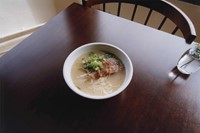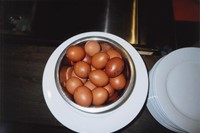AnOther Dish is a recipe and interview series with London-based chefs, spotlighting new openings and beloved, classic restaurants that stand the test of time.
Last summer, people in east London kept talking in hushed tones about a brand new Korean restaurant I just had to try: Miga. The ox bone broth, supposedly, was to die for, and I should get down there before it became a ’spot’. I googled it, finding next to nothing online, aside from an unassuming Instagram account with just one photo of the restaurant’s boxy white facade, located on the corner of Mare Street and Regent’s Canal in Hackney. Stencilled with bold illustrations – a cow, an ox, and a calf – alongside text proclaiming the restaurant’s ethos and the rich culinary history of the family behind it, the restaurant promised a “modern take” on Korean cuisine. Helmed by two brothers in their twenties – both go by the name of Jae Ko – and with their father, Hyun Sang Ko, in the kitchen, this intergenerational family business had an ambitious mission: to create the best Korean food London has ever seen. “Let’s get this bread,” read the sign, in the restaurant’s amusingly slang-ridden lexicon (there was also talk of “peng food”, “mumsy” and “rudegirl”).
I was intrigued, and after getting turned away with a polite but firm level of sass by the eldest brother, who was dressed immaculately in a white T-shirt and Homme Plissé Issey Miyake trousers – the family’s front-of-house de facto working uniform – I reserved a spot for lunch. Then, I finally understood. With its nourishing ox bone broth paired with beef brisket and noodles, crunchy blood-red kimchi, and beef tartare served with egg yolk, parsley and slivers of delicate Korean pear, this was, indeed, the best Korean food I had ever eaten in London. It also expanded and exploded my conception of what Korean food even is; the dishes on the menu were unlike any others on offer in London.
“This is how Korean food should be,” says the younger brother confidently. “Korean food has been saturated in London so much. All of us agree that there’s no Korean restaurant in London, other than my mum’s (Miga in Morden), to our standard. The menu is the same everywhere.” At Miga, guests can expect to eat more unusual dishes – a glutinous beef collagen salad, for example – alongside more familiar offerings like sea bream, fried duck, and braised pork belly, served alongside vibrant soy or gochugaru-based vinaigrettes.

Then there’s the bone broth, the star of the menu and the restaurant’s foundational dish, an intergenerational “heirloom” passed down to head chef Hyun Sang Ko from his grandmother, who was one of the top three chefs in Seoul during the 1970s. Hyun Sang Ko, who has been cooking professionally for 32 years, trained under Korean and Japanese master chefs in the 90s; his credentials include cooking for the Korean athletes at the London 2012 Summer Olympics, and working as the South Korean embassy’s representative chef for the UK. In person, Hyun Sang Ko is warm and funny, sending his two sons and daughter into hysterical fits of giggles; the family’s mutual affection and easygoing rapport is clearly one of the secret ingredients of this restaurant’s success. “Our parents have had restaurants our whole lives. We all grew up in them,” explains the younger Jae Ko, of the impetus behind finally opening their own.
“Korean food is either very commercial, very Westernised, like the barbecues, or extremely elevated and a fine dining experience,” the older brother chimes in. “But it never came across our mind to fill that gap in the market. It was just food that we’ve grown up eating and appreciated.” A stone’s throw from east London culinary institutions like Café Cecilia and Koya Ko on Broadway Market, the family wanted to set up shop in the area thanks to its unparalleled food culture. “Hackney showcases great restaurants and great cuisine. We’re amongst great company in this neighbourhood,” says the older Jae Ko. “The less PR-trained version of that answer is, this is where the competition is,” says the younger brother, who admits to having a competitive streak. “Our family is more than capable of rising above the competition, quite frankly, just based off our dad’s skills, our palette, taste and eye. I tried a couple of restaurants around here. And honestly, I thought we could do better than them.”

And just like the food it serves, the decor of Miga is self-assured, minimalist yet beautiful. The brothers, who designed the restaurant themselves (one has a background in graphic design and has worked at the Issey Miyake store previously) took cues from the already-existing ceiling, a jigsaw of wooden floorboards and exposed concrete beams. With sparse white walls – “I love negative space,” proclaims the younger Jae Ko – dark wooden tables, wicker chairs, baskets and an exquisite wooden bar separating the kitchen from the dining area, the restaurant’s rustic Korean aesthetic is inspired by the family’s own London house; the elegant design of a traditional wooden coat rack is lifted from one they had in their own home for 15 years.
‘Miga’ translates from Korean to English to mean a “flavourful or delicious, tasteful house”. And with highly attentive, warm service from the two brothers, one is made to feel part of the family when dining at Miga. “Miga is our house,” says the older Jae Ko. “We’re welcoming you into our house. Our house has never been elaborate or ornate. It’s very rustic, natural, warm and comforting in a strange way.”

Located behind the bar, there is just one piece of art in the whole restaurant – an emotional cipher for the entire venture. A minimalist, cartoonish drawing of five ducks taking flight, with open white space ahead of them, the piece was done by the family’s older brother. “This piece is about our family,” says the younger brother. “There’s five of us, and five ducks. It represents, ‘I don’t know where we’re going as a family, but there’s something ahead of us, and we’re gonna go whatever it is together.’ That’s why it’s there.”
Below, Miga head chef Hyun Sang Ko talks about his fridge staples, guilty pleasures, and favourite ingredients.

What’s the first meal you remember making? Korean ribeye stew.
What are your top three favourite restaurants in London? Wifey’s Miga in Morden, City Cafe 2 and Imperial China.
What’s the best and worst thing about the London food scene? You can have any cuisine in the world in London, but it’s difficult to find good food.
What’s your greatest extravagance? My knife.
What’s the best advice you’ve received? Even good chefs are still learning and training.
What do you do to feel inspired? “Be open-minded to everything, from images on supermarket food packaging to posters on the street” – Hyun Sang Ko
What’s the dish you eat most at home? Rice, kimchi, my wife’s pickles and spinach namul.
What are your fridge staples? Water, peaches, grapes and ice cream.
What’s your favourite thing to eat? Slow-cooked lamb shawarma (from the shoulder) at original Turkish restaurants.
What’s your favourite thing about being a chef? I’m happy because I’m making good food and coming up with new dishes. If you’re not happy, you can’t work in the kitchen because it’s too hard.
Where’s your favourite place to travel? Porto [in Portugal] and Antalya [in Turkey].

What did you eat today? For breakfast, I had a jacket potato with cheese and beans from City Cafe. For lunch, I had vermicelli noodle soup with roast duck and dim sum in Chinatown. For dinner, I had a kebab from a local shop in Morden.
What is your guilty pleasure? Ice cream.
If you weren’t a chef, what would you be doing? I’d be a PE teacher.
Who has most influenced your cooking? My mother – that’s why my tongue is fixed.
What’s one ingredient you can’t live without? Onions. They can change everything.
What’s one thing about Korean cuisine that gets overlooked? Korean cuisine is originally well-being, all-natural food.
What do you do to feel inspired? Be open-minded to everything, from images on supermarket food packaging to posters on the street. This is all free inspiration if you can apply your imagination.
What cookbook has inspired you most? 채소반찬. A book compiled of a series of namul recipes from 우먼센스 (Woman Sense magazine).
Describe a perfect day. A perfect day is when I have time to prep, meaning that everything is ready for the rest of the week for the food to be perfect.
What item would you save if your house was burning down? My underwear.
Miga in London is available to book now.






